Time and Money, the two most significant ingredients for the recipe of a successful life.
A mathematical point of view on time and money starts with the basics and moves your way upwards to understand more complex and advanced concepts interwoven with other branches of maths.
Practice is what makes those concepts engraved into your minds. So, the more you practice, the higher hold you have on them. Here is a set of Time and Money worksheets for you to practice on.
If you want to understand more on the Time and Money Concept – go the last section of this article.
Time and Money Worksheets
Telling Time Worksheet – All Levels
These one page worksheets cover telling time. Students look at a clock and write the correct
time.
Key concept: All Students need to practice their everyday time skills.
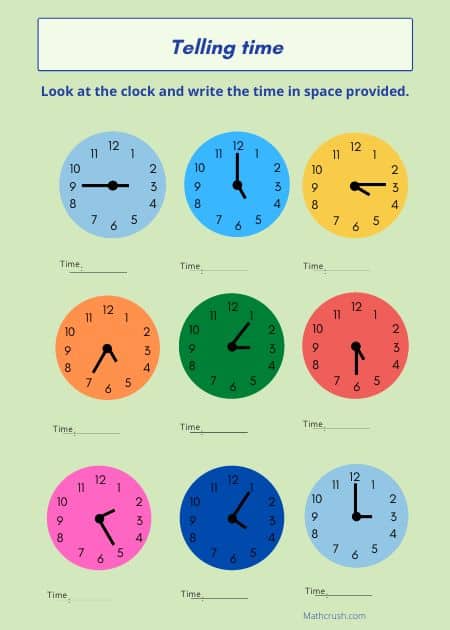
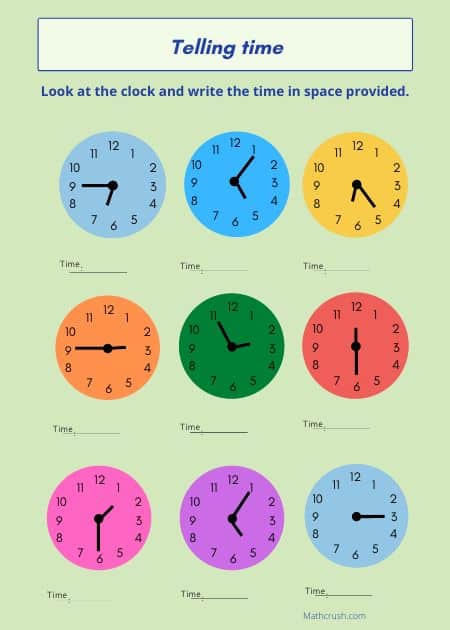

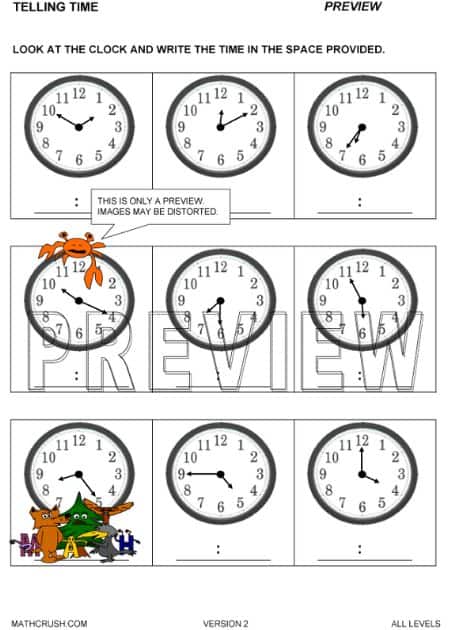
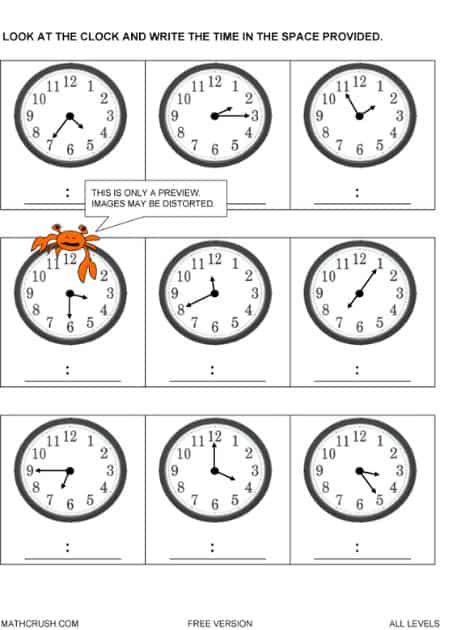
Creating Clocks – All Levels
These one page worksheets have students fill in the correct clock handles. Students look at the time
and draw in the clock.
Key concept: All Students need to practice their everyday time skills.
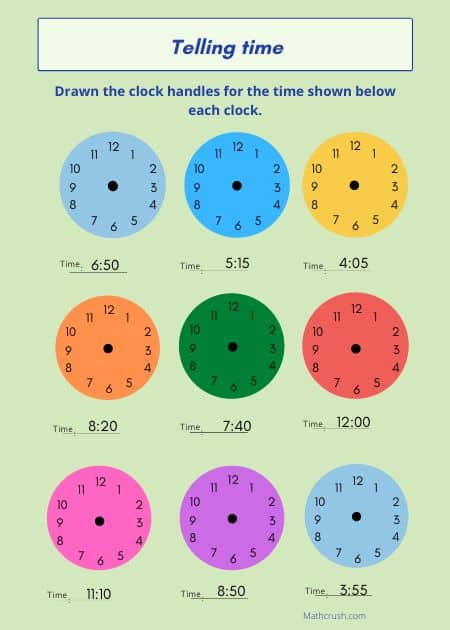
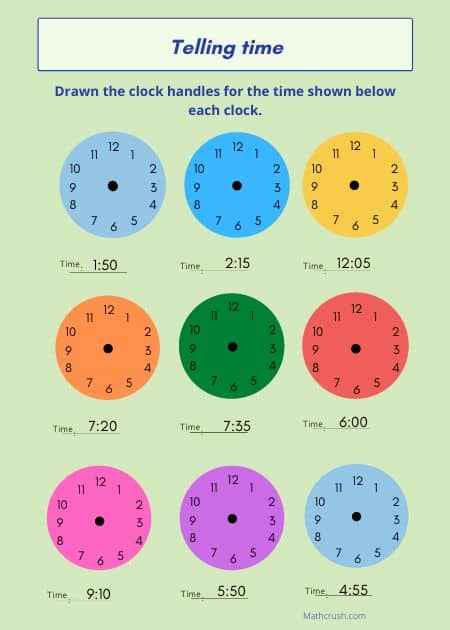
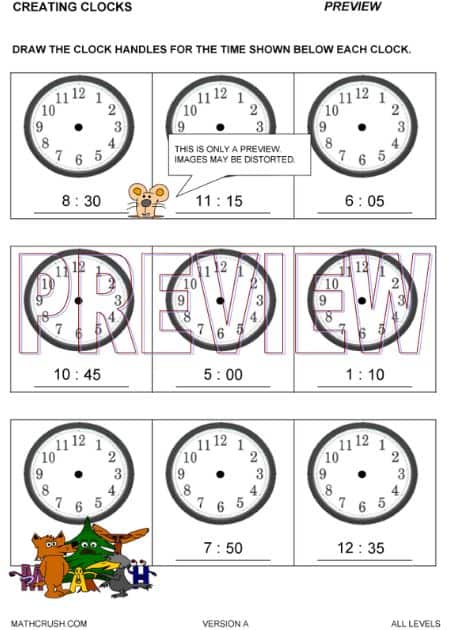
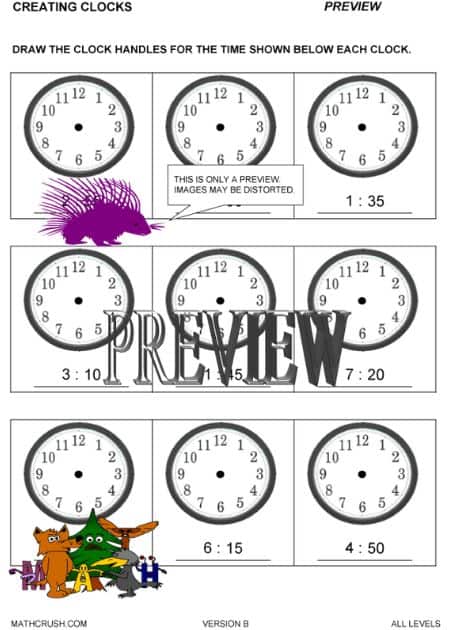
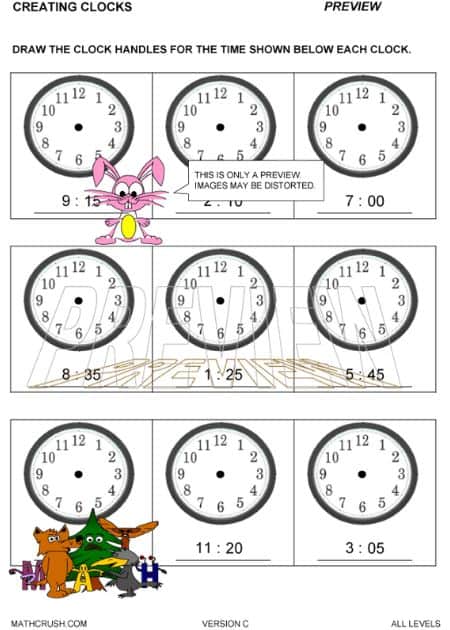
Answer, Find, and Shade Time Review Worksheet – Level 1
This art worksheet reviews time. Students read clocks, count minutes, and estimate hours.
Key concept: Students should be able to tell time, and determine the duration of intervals of time in minutes and hours.
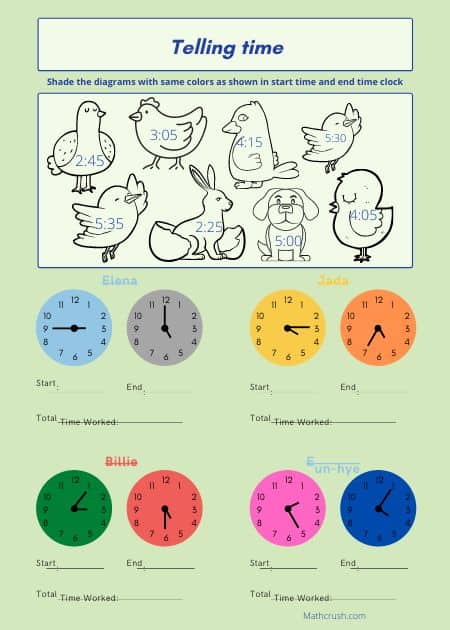

Time Art Worksheet – Level 2
This one page art worksheet helps students practice time. Students answer the word problems, find the answers in the grid, and then shade the squares that match the answers.
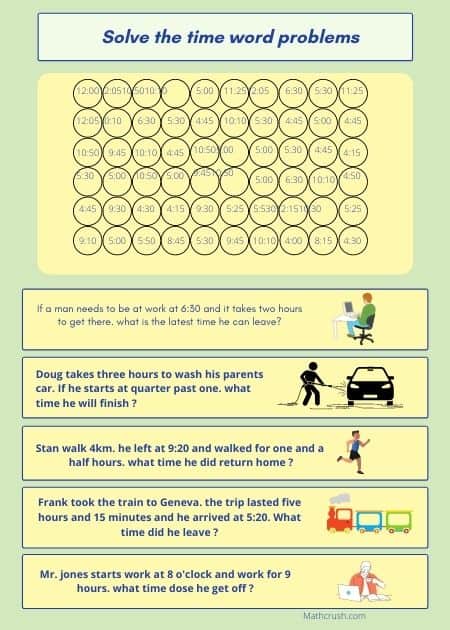
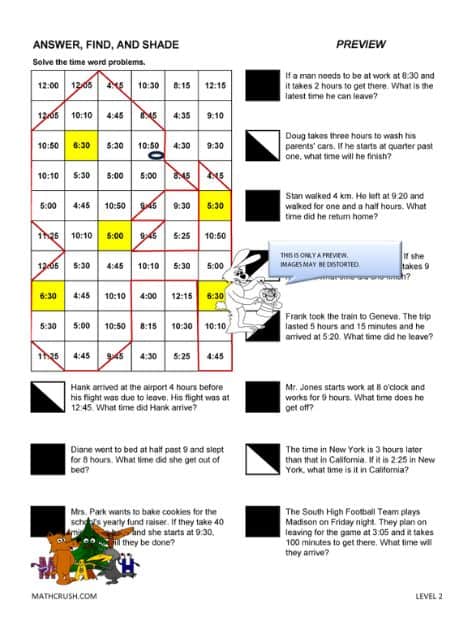
Answer, Find, and Shade
Using and Reading a Schedule Worksheet
These one page art worksheets have students practice reading a schedule. The schedule and picture become more difficult as the levels get higher. For example: Information is left out of the schedule and students must calculate what is missing.
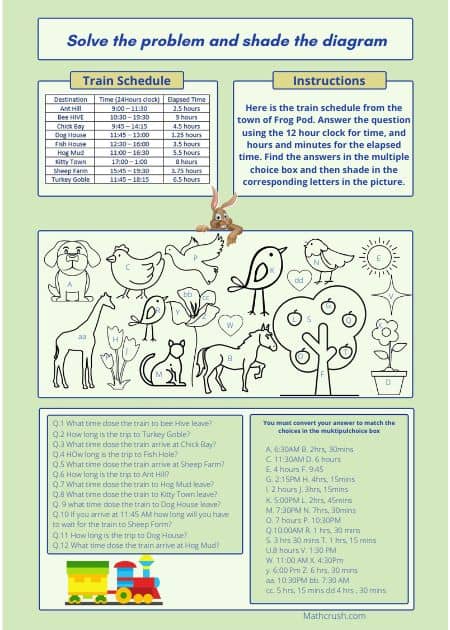
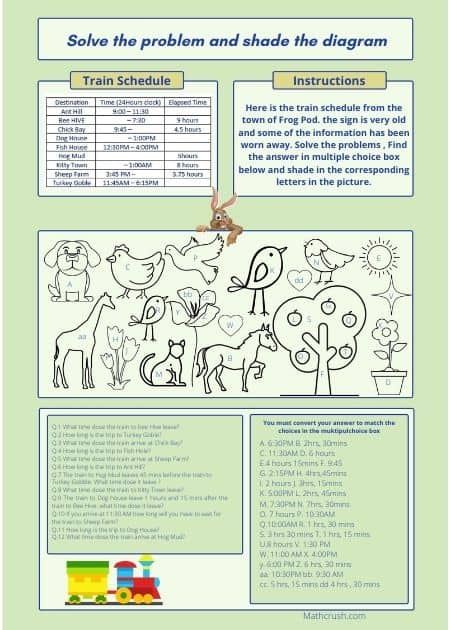
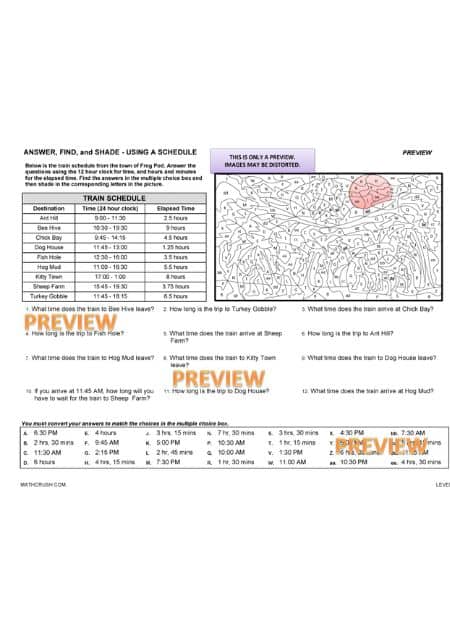
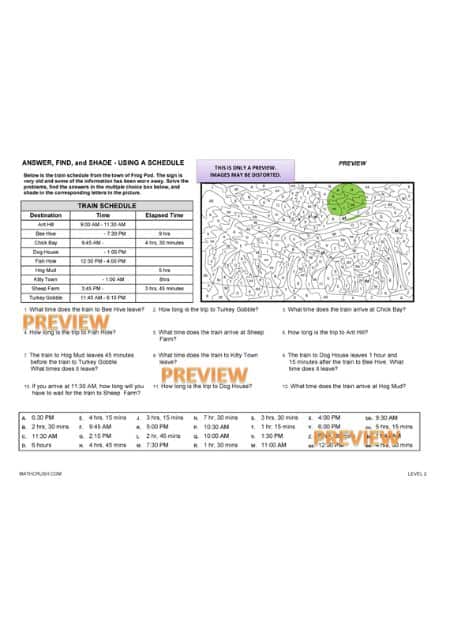
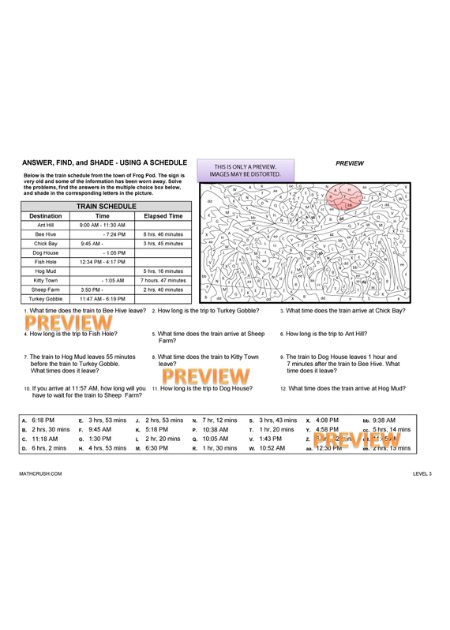
Calendar Vocabulary Worksheet – Level 1
This one page worksheet reviews basic calendar vocabulary. Students fill in the blanks using the given words.
Key concept: Students should be able to understand time and know key vocabulary related to seconds, minutes, hours, days, weeks, months andyears.
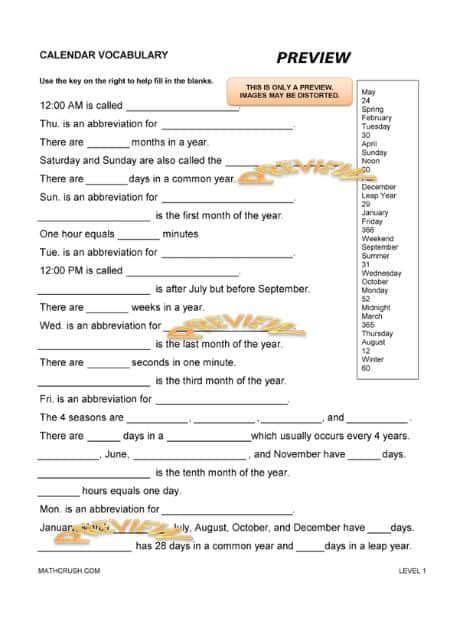
Calendar Review Worksheet – Level 2
This one page worksheet reviews basic calendar knowledge. Students answer questions about dates and days of the week using calendars.
Key concept: Students should be able to solve time measurement problems and collect information from a calendar.
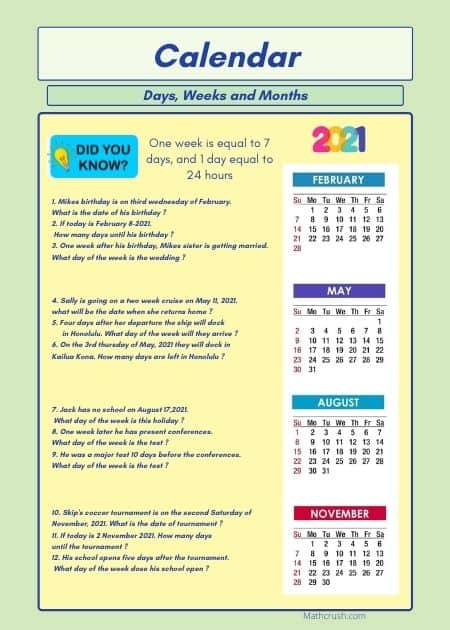
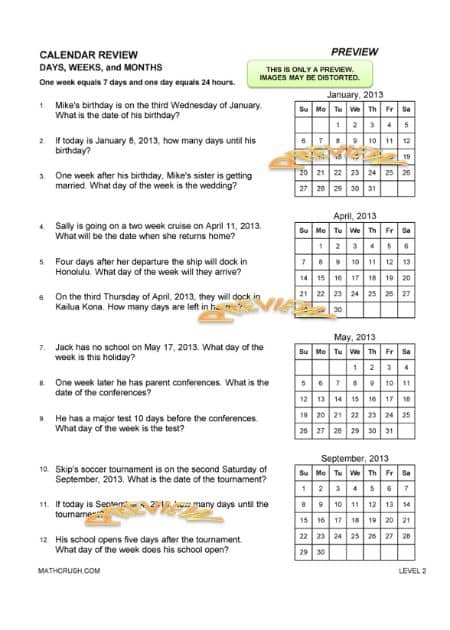
Counting Money Worksheet – Level 1
This one page worksheet has students add basic USA Currency. It only uses pennies, nickels, dimes, and quarters.
Key concept: Students should know and understand basic money and be able to add coins.
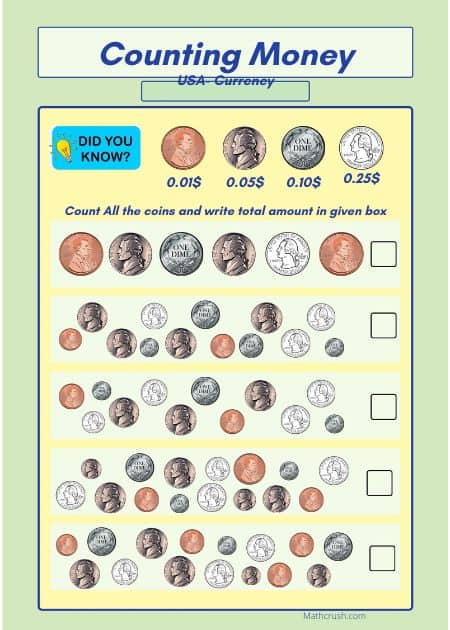
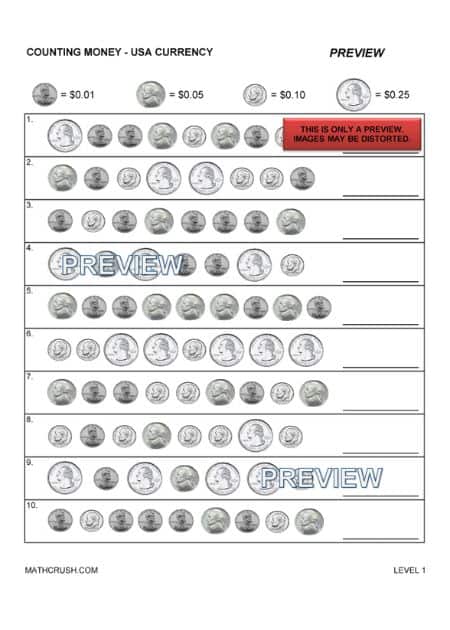
Answer, Find, and Shade Counting Money Worksheet – Level 2
This art worksheet reviews USA Currency. Students count dollars and change to calculate an amount.
Key concept: Students should be able to solve problems using different combinations of coins and bills.
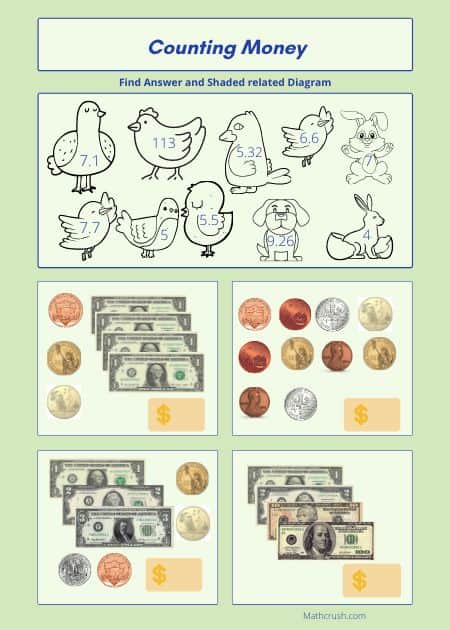
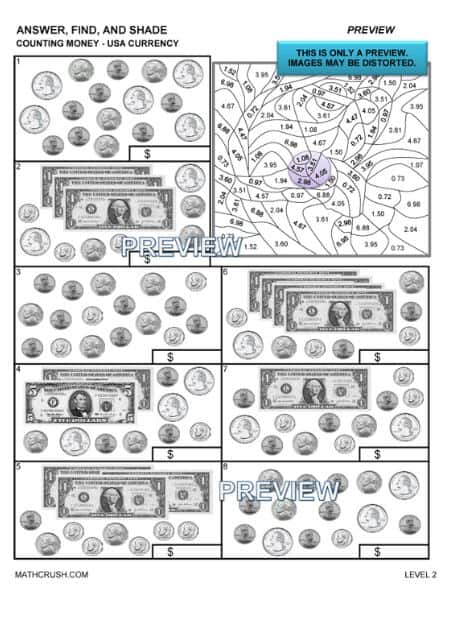
Buying and Change with USA Money – Worksheet Level 1
This one page worksheet has students use their knowledge of currency to purchase items and then calculate how much money Alligator Jack will have left after the purchase. It uses pennies, nickels, dimes, and quarters.
Key concept: Students should be able to count coins, and add and subtract money (currency).
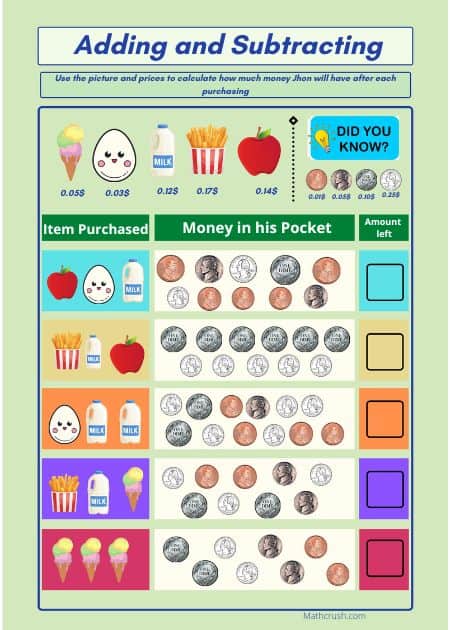
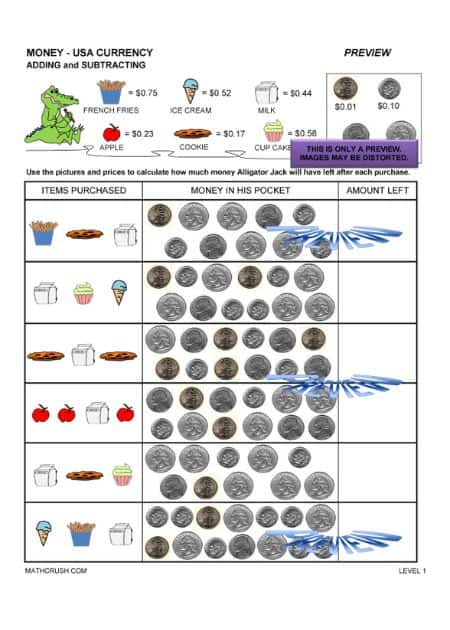
Stained Glass Money Review Worksheet– Level 1
This art worksheet reviews money (USA Currency). It includes basic change, rounding to the nearest dollar, and adding and subtracting money. Each student chooses their own colors to create a unique art project.
Key concept: Understand money amounts in decimal notation.
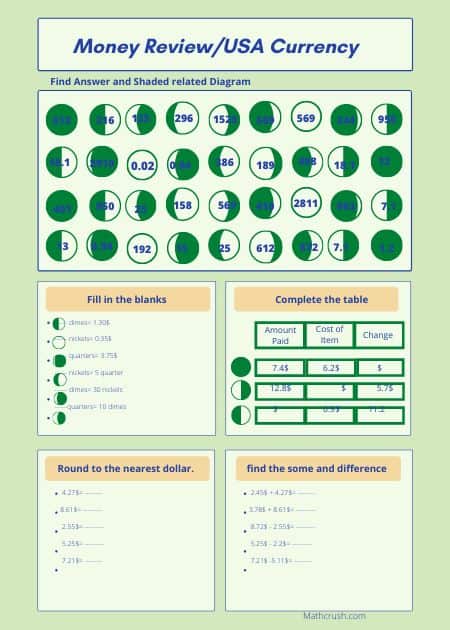
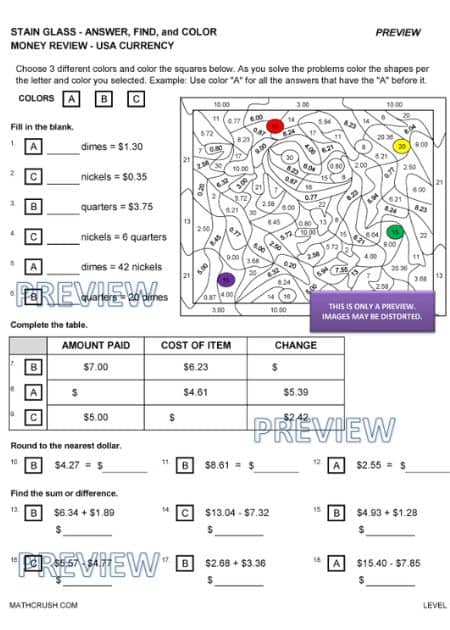
Money Word Problems Worksheet
These one page word problem worksheets review money, which are great for warm-ups or just some review. There are three different levels that have similar problems but the amounts are different.
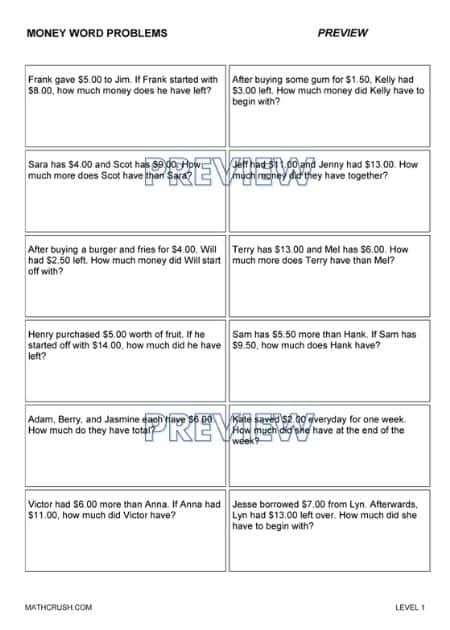
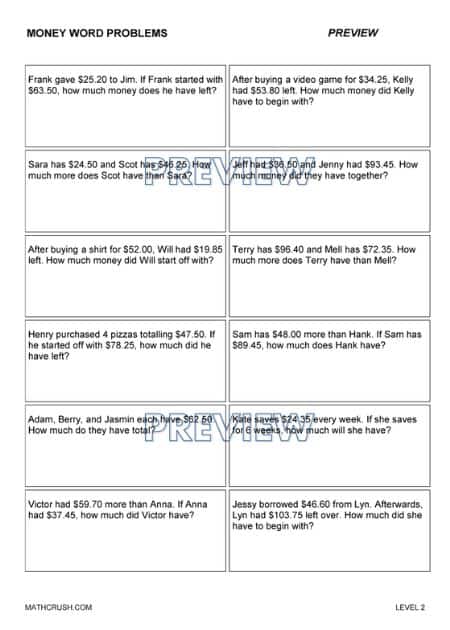
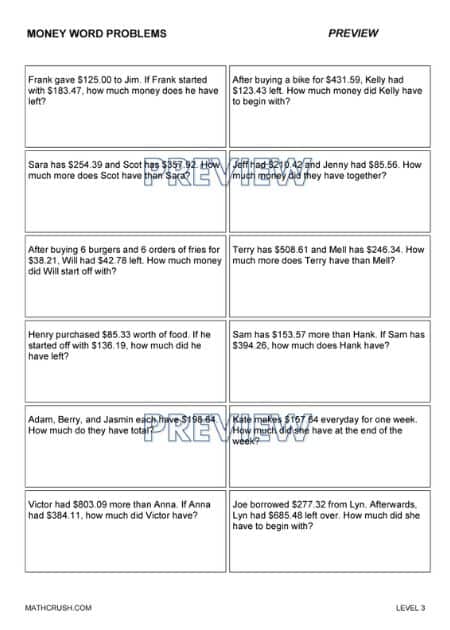
Money with Change Worksheet – Level 1
These one page worksheets review purchasing items and calculating change. Students are given $10.00 to purchase three separate items, and calculate the total and the change they will receive back. They do this process five different times.
Key concept: Students should practice everyday mathematical experiences.
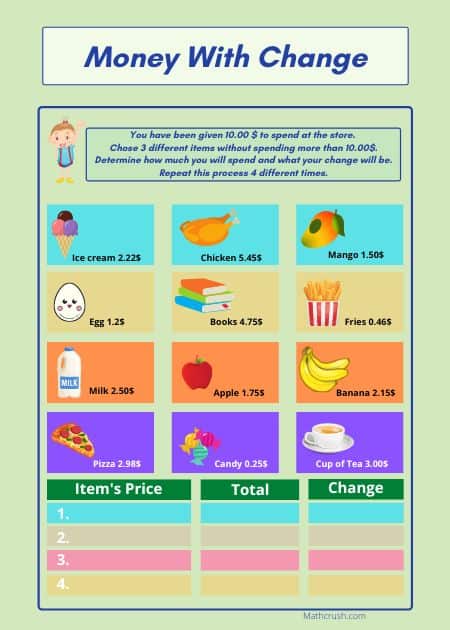
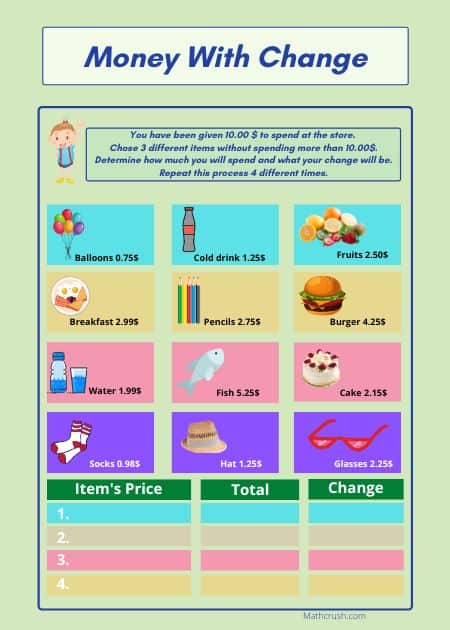
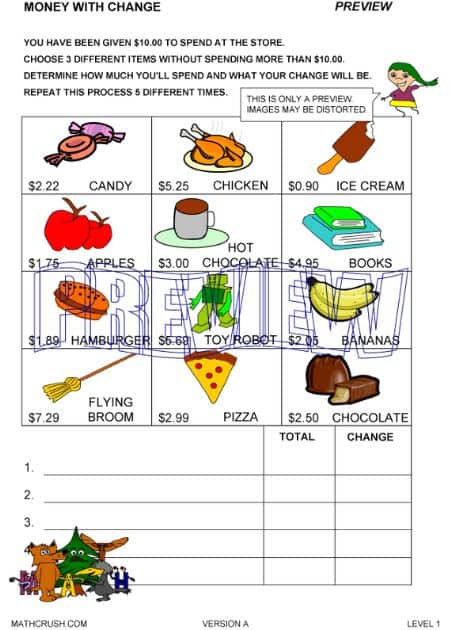
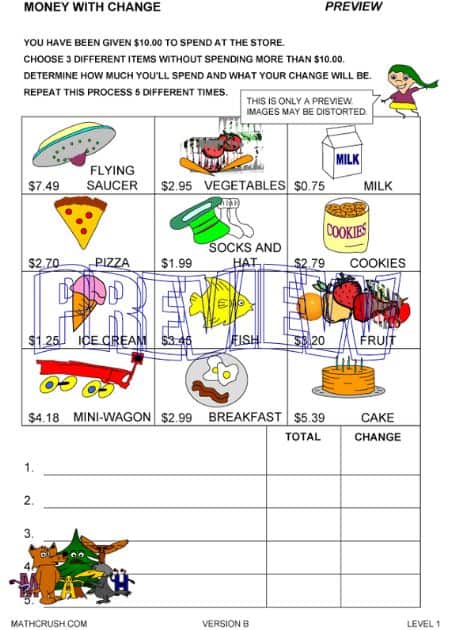
Money with Change Worksheet – Level 2
These one page worksheets review purchasing items and calculating change. Students are told they’re going on a trip and need to purchase some new equipment. They need to purchase items, calculate the total, and determine their change.
Key concept: Students should practice everyday mathematical experiences.
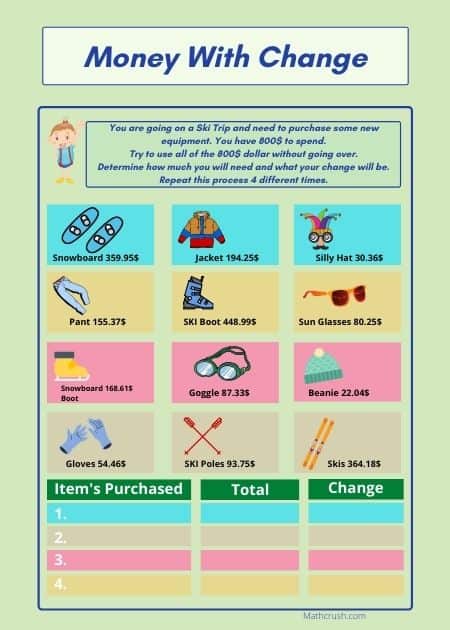
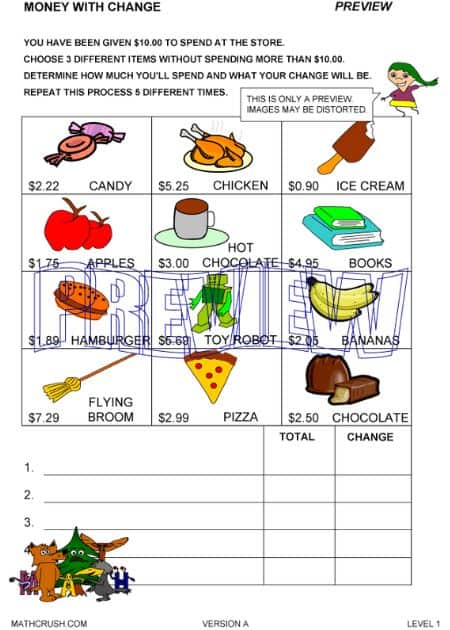
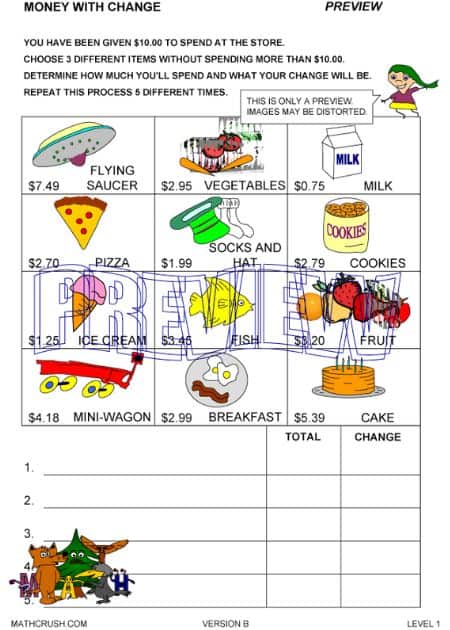
Who Done It? Word Problem Worksheet – All Levels
This one page worksheet has students use their basic math skills to solve a robbery. They read the information and look at the pictures to figure out who committed the crime.
Student misunderstanding: To solve the crime students need to use the information in the picture to confirm each person’s alibi.
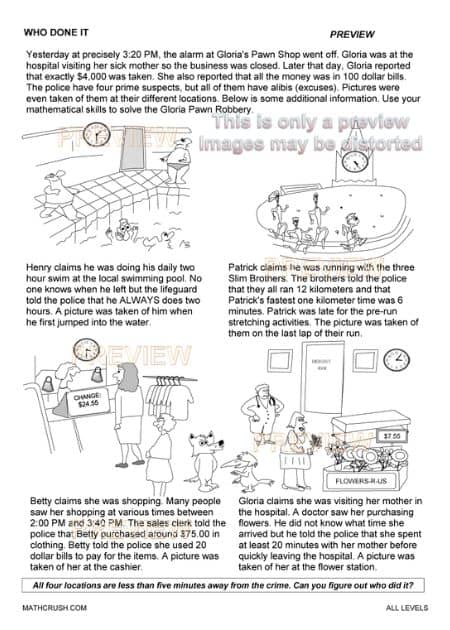
Understanding Time & Money Math Concept
A few foundational and fundamental concepts of time and money will help you understand their practical use in your everyday life.
Time
It is the measurement of a day or night or both to keep track of performing different activities like school or office hours, holidays, cooking time, when to go to sleep, and when to get up.
- How to Draw a Clock?
A clock is of a simple circular shape with numbers 1-12 equally placed along its edges. These mark the 12 hours in a day and then again 12 hours of night, accounting for the total of 24 hours.
The 24-hour cycle begins from night 12 and is marked as mid-day when the clock strikes 12 again. The time between night 12 and day 12 falls under ‘am,’ and the time between day 12 and night 12 falls under ‘pm.’
12:00 am is called ‘Midnight,’ and 12:00 pm is called ‘Afternoon.’
It also has two pointed needles pointing towards the digits. One is longer, and the other is shorter.
A third needle is also present, which is the same length as the longer one but thinner. These are of different shapes for you to easily differentiate between them.
You may think that how do I know about hour divisions? Well, to answer that question of yours, you will need to move to the next question.
- What are Seconds, Minutes and Hours?
The time that passes between the two digits on the clock, for example, from 5 to 6, is called an hour. Let me elaborate.
60 seconds make up 1 minute, and 60 minutes make up 1 hour. The longer pointed needle or arm measures minutes, while the shorter arm measures hours. The third thinner arm measures seconds.
The thinner arm makes a complete circle the fastest as it calculates seconds, which occurs the fastest in time. The second-place taker in the speed is the minute’s arm, which circles with a medium speed. The third-place taker and the slowest of all three is the hour’s arm as it accounts for one whole hour.
A more straightforward explanation is, for 1 hour to pass by, the seconds arm circles 3600 times and the minute’s arm circles 60 times.
Between two digits, there are five divisions. For seconds and minutes, 1 division equals 1 second and 1 minute, respectively.
- How to Read Time on a Clock?
Nowadays, you have digital clocks that show the exact time without needing to calculate anything. But, if you were to come across an analog watch or clock, you will need to know how to read the time on it.
Reading time on a clock is not hard. All you need is practice, and then it will be more than you can imagine. Let us take an example.
Note: You do not need to calculate the seconds too while reading time. Just the hour and minutes are enough.
If the minute hand is on the digit 6 and the hour hand is on 4, the time is 4:30 pm.
The number on which the hour arm is present defines the hour number. And if the hour arm is between two numbers, you should take the number before the arm.
For the minute calculation, instead of the 1-12 digits, you need to calculate the number of divisions beginning from 12. From 12 to 6, with 5 divisions between each, will add to 30 divisions. So, 30 is the number for minutes.
The last step: designating whether it’s day or night. Here pm is mentioned, and so it is daytime.
Hence, the time is 4:30 pm.
- How does a Calendar show you Time?
A Calendar is an enlarged version of how time can be observed and recorded. Though it does have arms and numbers to be read, it works on the concept of not one 24-hour cycle like a clock, but many such 24-hour cycles.
Seven 24-hour cycles make up 1 week, 30 or 31 such 24-hour cycles make up 1 month, 12 such months make up 1 year—the entire of which consists of 365 24-hour cycles.
To simplify, let us consider one 24-hour cycle as 1 day. So the 7 days in a week are Monday, Tuesday, Wednesday, Thursday, Friday, Saturday, and Sunday, and their respective abbreviations are Mon, Tue, Wed, Thu, Fri, Sat, and Sun.
The 12 months in a year are January, February, March, April, May, June, July, August, September, October, November, and December. However, there is no name for years.
One exception to note is that February is not of 30 or 31 days, but 28 days. And once every four years, this month has 29 days, and the year is called a leap year.
Money
Exchange of products was the ancient way of gaining the things you wish to acquire. Today, each country has its own currency and a symbol, not repeatable or copyable.
Further, Currency is divided into notes and coins for more accessible exchanges and to avoid mistakes. Notes are often made of rectangular-shaped paper, while coins are of the circular shape formed of copper, zinc, or nickel (metals).
- What are the Different Types of Coins?
USA’s currency is Dollar with the symbol ‘$’. So let us take Dollar as an example for understanding the concept better.
The basic types of dollar denominations (amount divisions) are cent, nickel, dime, quarter, half a dollar, and 1 dollar. There are also divisions above 1 dollar that are 2, 5, 10, 20, 50, and 100 dollars each.
All 1 and above 1 dollar are paper currency, whereas the below 1 dollar are all coins manufactured.
1 cent
5 cents = 1 nickel
2 nickels = 1 dime (10 cents)
2 dimes + 1 nickel = 1 quarter (25 cents)
2 quarters = 1 half dollar (50 cents)
- How is Money Represented?
If a product has a price tag of $14.34, then what do you understand from this? Let’s break down.
The symbol of a currency is always written first, followed by the number of dollars. A tricky point is the decimal point.
Numbers written after the decimal point represent cents, i.e., less than 1 whole dollar, hence placed after denoting the whole dollars. So in the above-given example, the product costs 14 dollars and 34 cents.
Why spelled only cents when it can also be said in nickels, dimes, or quarters? Notation in cents is easier to know, display, and calculate, and so is used far more times than other measurements.
- How to carry out different Arithmetic Operations with Money?
You will need money when you go to a grocery shop to buy chocolates, toffees, candies, lollipops, juice, bread, eggs, milk, etc. And, if you do not know how much the product costs and the remaining balance money that should be returned to you after payment, how will you prevent being fooled and lose money?
On that account, you will need to learn different arithmetic operations like addition, subtraction, multiplication, and division. Under each sub-heading, the concept has been explained with examples for better grasping.
- Addition
This will involve simple to complex additions of money; all combinations:
note + note,
coin + coin, and
note + coin.
Example: You buy one chocolate for $0.34 and one candy for $0.66. What will be the total cost?
Method: Add the cents first and then the whole dollars. So, the addition of 34 and 66 will give 100, of which you will add the 1 to the whole dollar side.
Therefore, the total bill will be $1.00
- Subtraction
This often happens when you have no change and only whole dollar bills. So, the grocery storekeeper will need to give you back the remaining amount.
Example: You have a $100 bill. The total bill of the list items bought by you comes to around $76.32. What is the difference the shopkeeper will have to give you back?
Method: Subtracting 76.32 from 100 will give you 23.68, which equals the cashback: 23 dollars and 68 cents.
- Multiplication
Bulk buying is where multiplication comes into play. A wedding festivities list, a stationary inauguration, or a new auditorium opening, you will need multiple flowers, pencil boxes, and chairs, respectively.
Example: There are 40 classmates in your class. You are celebrating your birthday and are going to the convenience store to buy 40 chocolates. Each one cost $0.81. What is the total money you will have to spend?
Method: Since you will need 40 0.81 dollars not to leave any of your classmates out, simply multiply with 0.81. The result is $32.40, which is the total money you will have to spend.
- Division
The division is an operation of rare occurrence. It is not usually required, but you should know how to go about it and not be clueless if it does come up.
Example: Suppose the bill format shows the total and not the individual division. Now how will you explain to your mother how much each of the 3 cupcakes cost you, given that the total is $14.70?
Method: All you have to do is perform a simple division of 14.70 by 3, and you will get the answer to be 4.9, which is the cost of $4.90 for each of the delicious vanilla strawberry and chocolate flavored cupcakes.
- What is Rounding Up to the nearest Amount?
Rounding up means, instead of writing or saying the numbers after the decimal for accurate calculation, you can simply tell the overall dollar number for easy understanding.
However, you should follow two rules for rounding up:
- If the number is less than half of the total, it should be rounded up to the previous number.
- If the number is half or more than half of the total, it should be rounded up to the following number.
Example 2: If the cost of a bread packet is $1.75, you can round up it to 2 dollars because 75 cents are more than the 50 cents or the halfway mark.
Example 1: If the cost of a pair of scissors is $1.49, you can round up it to 1 dollar because 49 cents are less than the 50 cents or the halfway mark.
